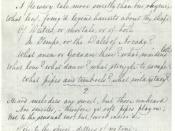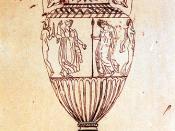"Ever since I've known the Japanese man who sits on the convex surface of my teapot, he has yet to make a move. He has never savoured the hand of the woman who is forever out of reach. Enervated colours, like those of an emptied , poured out sun, eternally unrealize the slopes of that hill. And the whole scene observes a moment of sorrow- a sorrow more faithful than the one that right now fills, without filling, the hollowness of my weary hours." In this observation by the Portuguese poet Pessoa we are introduced to the notion of a moment being contained, forever frozen in time. This notion of containment and the opposition to the nature of this force is an ideal lens through which we might examine Keats's " Ode on a Grecian Urn" and Steven's "Anecdote of the Jar". Through the use of similar iconography, even one seen on a teapot, the moment is not only contained but sustained.
Pessoa describes how art can continually represent what time dissipates so that we might further our appreciation of an occasion or situation which in itself is too ephemeral, or too emotionally demanding when directly experienced, to allow for detailed interpretation. These works by Keats and Stevens differ in several areas: style, tone, meter and content and yet both are inextricably linked in that they both hold or contain images in time through the use of a man made object. Importantly the objects in both poems are forms of containers. The very nature of a container proposes the idea of restraint. A container keeps things- keeps things in and keeps things out, and its raison d'etre is to protect matters from decay. Containers, then are always symbolic of struggle - the fight to be released versus...


